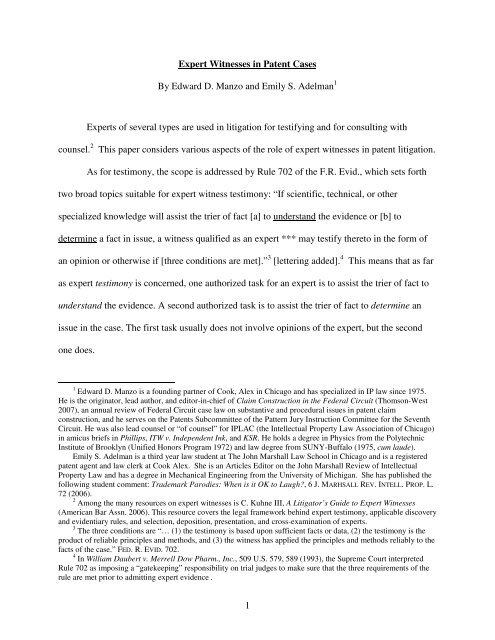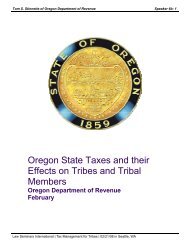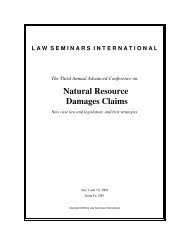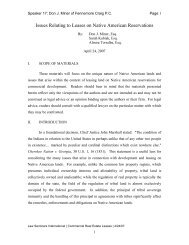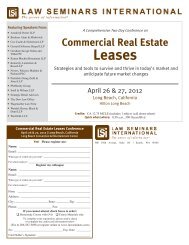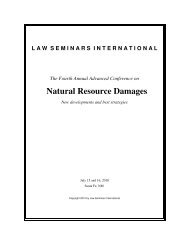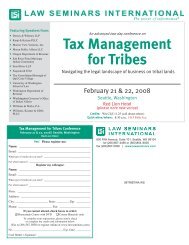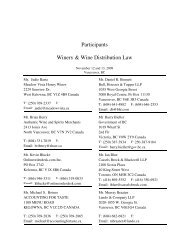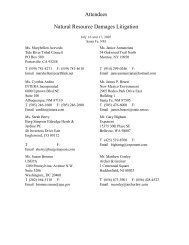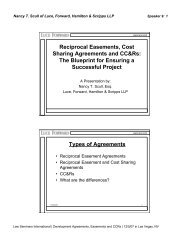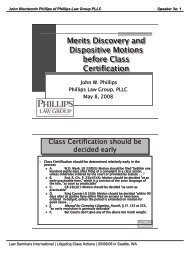1 Expert Witnesses in Patent Cases By Edward D. Manzo and Emily ...
1 Expert Witnesses in Patent Cases By Edward D. Manzo and Emily ...
1 Expert Witnesses in Patent Cases By Edward D. Manzo and Emily ...
You also want an ePaper? Increase the reach of your titles
YUMPU automatically turns print PDFs into web optimized ePapers that Google loves.
<strong>Expert</strong> <strong>Witnesses</strong> <strong>in</strong> <strong>Patent</strong> <strong>Cases</strong><br />
<strong>By</strong> <strong>Edward</strong> D. <strong>Manzo</strong> <strong>and</strong> <strong>Emily</strong> S. Adelman 1<br />
<strong>Expert</strong>s of several types are used <strong>in</strong> litigation for testify<strong>in</strong>g <strong>and</strong> for consult<strong>in</strong>g with<br />
counsel. 2<br />
This paper considers various aspects of the role of expert witnesses <strong>in</strong> patent litigation.<br />
As for testimony, the scope is addressed by Rule 702 of the F.R. Evid., which sets forth<br />
two broad topics suitable for expert witness testimony: “If scientific, technical, or other<br />
specialized knowledge will assist the trier of fact [a] to underst<strong>and</strong> the evidence or [b] to<br />
determ<strong>in</strong>e a fact <strong>in</strong> issue, a witness qualified as an expert *** may testify thereto <strong>in</strong> the form of<br />
an op<strong>in</strong>ion or otherwise if [three conditions are met].” 3 [letter<strong>in</strong>g added]. 4<br />
This means that as far<br />
as expert testimony is concerned, one authorized task for an expert is to assist the trier of fact to<br />
underst<strong>and</strong> the evidence. A second authorized task is to assist the trier of fact to determ<strong>in</strong>e an<br />
issue <strong>in</strong> the case. The first task usually does not <strong>in</strong>volve op<strong>in</strong>ions of the expert, but the second<br />
one does.<br />
1 <strong>Edward</strong> D. <strong>Manzo</strong> is a found<strong>in</strong>g partner of Cook, Alex <strong>in</strong> Chicago <strong>and</strong> has specialized <strong>in</strong> IP law s<strong>in</strong>ce 1975.<br />
He is the orig<strong>in</strong>ator, lead author, <strong>and</strong> editor-<strong>in</strong>-chief of Claim Construction <strong>in</strong> the Federal Circuit (Thomson-West<br />
2007), an annual review of Federal Circuit case law on substantive <strong>and</strong> procedural issues <strong>in</strong> patent claim<br />
construction, <strong>and</strong> he serves on the <strong>Patent</strong>s Subcommittee of the Pattern Jury Instruction Committee for the Seventh<br />
Circuit. He was also lead counsel or “of counsel” for IPLAC (the Intellectual Property Law Association of Chicago)<br />
<strong>in</strong> amicus briefs <strong>in</strong> Phillips, ITW v. Independent Ink, <strong>and</strong> KSR. He holds a degree <strong>in</strong> Physics from the Polytechnic<br />
Institute of Brooklyn (Unified Honors Program 1972) <strong>and</strong> law degree from SUNY-Buffalo (1975, cum laude).<br />
<strong>Emily</strong> S. Adelman is a third year law student at The John Marshall Law School <strong>in</strong> Chicago <strong>and</strong> is a registered<br />
patent agent <strong>and</strong> law clerk at Cook Alex. She is an Articles Editor on the John Marshall Review of Intellectual<br />
Property Law <strong>and</strong> has a degree <strong>in</strong> Mechanical Eng<strong>in</strong>eer<strong>in</strong>g from the University of Michigan. She has published the<br />
follow<strong>in</strong>g student comment: Trademark Parodies: When is it OK to Laugh?, 6 J. MARHSALL REV. INTELL. PROP. L.<br />
72 (2006).<br />
2 Among the many resources on expert witnesses is C. Kuhne III, A Litigator’s Guide to <strong>Expert</strong> <strong>Witnesses</strong><br />
(American Bar Assn. 2006). This resource covers the legal framework beh<strong>in</strong>d expert testimony, applicable discovery<br />
<strong>and</strong> evidentiary rules, <strong>and</strong> selection, deposition, presentation, <strong>and</strong> cross-exam<strong>in</strong>ation of experts.<br />
3 The three conditions are “… (1) the testimony is based upon sufficient facts or data, (2) the testimony is the<br />
product of reliable pr<strong>in</strong>ciples <strong>and</strong> methods, <strong>and</strong> (3) the witness has applied the pr<strong>in</strong>ciples <strong>and</strong> methods reliably to the<br />
facts of the case.” FED. R. EVID. 702.<br />
4 In William Daubert v. Merrell Dow Pharm., Inc., 509 U.S. 579, 589 (1993), the Supreme Court <strong>in</strong>terpreted<br />
Rule 702 as impos<strong>in</strong>g a “gatekeep<strong>in</strong>g” responsibility on trial judges to make sure that the three requirements of the<br />
rule are met prior to admitt<strong>in</strong>g expert evidence .<br />
1
What are the roles of testify<strong>in</strong>g experts <strong>in</strong> patent cases? <strong>Patent</strong> cases <strong>in</strong>herently <strong>in</strong>volve<br />
assertions about technology – what the <strong>in</strong>vention is (claim construction), whether it is used<br />
(<strong>in</strong>fr<strong>in</strong>gement), whether it meets conditions for patentability (validity), <strong>and</strong> on occasion whether<br />
there are issues over the disclosures to the <strong>Patent</strong> <strong>and</strong> Trademark Office (PTO) – be they<br />
regard<strong>in</strong>g prior art, test<strong>in</strong>g, etc. As such, patent cases <strong>in</strong>volve subject matter that is often the<br />
subject of specialized knowledge <strong>and</strong> hence are fertile ground for the use of experts. Hence,<br />
these traditional topics addressed by experts <strong>in</strong> patent cases are: (1) to prove or disprove<br />
<strong>in</strong>fr<strong>in</strong>gement, (2) to prove patent <strong>in</strong>validity or rebut such attacks, <strong>and</strong> occasionally (3) to<br />
comment on practices <strong>and</strong> procedures <strong>in</strong> prosecut<strong>in</strong>g patents before the USPTO.<br />
The pla<strong>in</strong>tiff’s burden is not only to show liability but also to prove <strong>and</strong> quantify damages<br />
<strong>in</strong> a non-speculative way. The patent statute provides for damages not less than a reasonable<br />
royalty, but it also allows lost profits <strong>in</strong> appropriate cases. One ord<strong>in</strong>arily uses an expert to<br />
quantify damages, <strong>and</strong> hence we add (4) to establish the amount of damages.<br />
In these four uses, the expert is presented for purposes of help<strong>in</strong>g to persuade the trier of<br />
fact. This list of four customary experts is not complete. <strong>Patent</strong> cases are lawsuits <strong>and</strong> as such<br />
further expertise can be brought to bear beyond the attorney’s arguments <strong>and</strong> presentations.<br />
Currently, one should also engage (5) an expert on electronic forensics to assist with document<br />
discovery, production, <strong>and</strong> related issues. Two further uses of an expert witness are: (6) <strong>in</strong><br />
prepar<strong>in</strong>g <strong>and</strong> present<strong>in</strong>g a technology tutorial dur<strong>in</strong>g (or before) the claim construction phase of<br />
the case, <strong>and</strong> (7) <strong>in</strong> preparation of demonstrative exhibits, which can relate to any or all of the<br />
topics mentioned already.<br />
Some of these experts will be testify<strong>in</strong>g while others need not. A 1996 article by Molloy<br />
et al. (“Molloy”) on the use of experts po<strong>in</strong>ts out how an expert may be used <strong>in</strong> general, not<strong>in</strong>g<br />
2
these reasons that are not specific to patent cases but are nevertheless certa<strong>in</strong>ly valid<br />
observations:<br />
(1) to assist you <strong>in</strong> learn<strong>in</strong>g the subject matter <strong>in</strong> issue;<br />
(2) to assess the record for completeness;<br />
(3) to identify issues otherwise missed;<br />
(4) to assist you <strong>in</strong> draft<strong>in</strong>g <strong>in</strong>terrogatories <strong>and</strong> requests for production by<br />
suggest<strong>in</strong>g questions to ask <strong>and</strong> <strong>in</strong>formation <strong>in</strong> request;<br />
(5) to respond to expert <strong>in</strong>terrogatories;<br />
(6) to evaluate your opponent's response to <strong>in</strong>terrogatories;<br />
(7) to assist you <strong>in</strong> prepar<strong>in</strong>g to depose <strong>and</strong> cross-exam<strong>in</strong>e oppos<strong>in</strong>g counsel's<br />
expert;<br />
(8) to draft technical questions for use <strong>in</strong> question<strong>in</strong>g the oppos<strong>in</strong>g party <strong>and</strong> the<br />
oppos<strong>in</strong>g expert;<br />
(9) to sit <strong>in</strong> on or otherwise evaluate the deposition of the oppos<strong>in</strong>g party <strong>and</strong> the<br />
oppos<strong>in</strong>g expert; <strong>and</strong><br />
(10) to help frame the direction from which you will present evidence. 5<br />
Molloy’s 10 observations relate to use of the expert after litigation has commenced, but an expert<br />
can also be used before suit is filed. An expert can help to assess the case. For example, a<br />
prospective pla<strong>in</strong>tiff may turn to experts to evaluate the merits of the <strong>in</strong>fr<strong>in</strong>gement case, identify<br />
potential weaknesses <strong>in</strong> the validity of the patent, <strong>and</strong> give some idea about damages. For a<br />
company that is aware of an <strong>in</strong>fr<strong>in</strong>gement charge or an adversely-held patent that has a chance of<br />
be<strong>in</strong>g asserted <strong>in</strong> litigation, counsel may engage an expert to identify <strong>and</strong> evaluate defenses.<br />
A. Characteristics of <strong>Expert</strong> <strong>Witnesses</strong><br />
The characteristics of a good expert witness follow from the contemplated task <strong>and</strong> the<br />
audience the expert is expected to serve. Select<strong>in</strong>g a testify<strong>in</strong>g expert <strong>in</strong>volves a host of factors<br />
that simply do not apply when the expert is hired to assess the case, educate the lawyer, prepare a<br />
5<br />
Maureen K. Molloy, Patricia S. Orr & Lawrence D. Copp, Five Steps to Us<strong>in</strong>g <strong>Expert</strong> <strong>Witnesses</strong> Effectively,<br />
22 VERMONT BAR J. & L. DIG. 14, 16 (1996).<br />
3
tutorial, prepare exhibits, assist with discovery, or testify <strong>in</strong> declarations to be filed with the court<br />
on why an adversary’s electronic discovery is deficient or why the adversary has spoiled the<br />
evidence.<br />
When it comes to testify<strong>in</strong>g experts, common sense is a good guide. You want the expert<br />
to help conv<strong>in</strong>ce the judge or jury that your position is correct (<strong>and</strong> that your opponent’s is<br />
wrong). From this perspective, the best expert is the one who is most persuasive. Such an expert<br />
(a) has been qualified by a court, (b) has actually testified at trial many times before, possibly on<br />
your technology or on your po<strong>in</strong>t, <strong>and</strong> (c) has generally persuaded the jury <strong>in</strong> his or her favor<br />
(<strong>and</strong> whose testimony has withstood appellate review).<br />
However, to exp<strong>and</strong> that a bit <strong>and</strong> apply a more rigorous approach, the authors of one law<br />
review article analyzed <strong>in</strong>terviews of over 200 jurors <strong>in</strong> 36 civil cases <strong>and</strong> developed a<br />
comprehensive model of the key factors that jurors consider when they are judg<strong>in</strong>g the credibility<br />
of an expert witness. 6<br />
This research revealed that what makes an expert a good one does not<br />
depend on any s<strong>in</strong>gle characteristic. 7<br />
Instead, jurors associated the follow<strong>in</strong>g characteristics with<br />
credible testimony:<br />
• lack of bias;<br />
6 Sanja Kutnjak Ivkovic & Valerie P. Hans, Jurors’ Evaluations of <strong>Expert</strong> Testimony: Judg<strong>in</strong>g the Messenger<br />
<strong>and</strong> the Message, 28 LAW & SOC. INQUIRY 441 (2003). This law review article made the follow<strong>in</strong>g analogy<br />
regard<strong>in</strong>g expert witnesses:<br />
[E]xpert witness<strong>in</strong>g may be characterized as a ‘performance.’ Lawyers commission <strong>and</strong> direct<br />
these presentations. The determ<strong>in</strong>ants of the performance beg<strong>in</strong> with the lawyer’s choice of a<br />
performer (cast<strong>in</strong>g) <strong>and</strong> proceed to the content of the testimony (script) <strong>and</strong> the manner of<br />
presentation (stag<strong>in</strong>g). If these efforts are successful, the audience’s perceptions of the messenger<br />
<strong>and</strong> the message unite to form their reaction to a performance that is designed to have a specific<br />
impact – like the <strong>in</strong>tertw<strong>in</strong><strong>in</strong>g of character <strong>and</strong> plot <strong>in</strong> a play. As we learn more about how jurors<br />
respond to experts, it is worthwhile to keep <strong>in</strong> m<strong>in</strong>d that the dimensions of expert performance are<br />
chosen <strong>and</strong> created with the aim of <strong>in</strong>fluenc<strong>in</strong>g jury decision mak<strong>in</strong>g. Arguably, one important<br />
function of adversarial cross-exam<strong>in</strong>ation is to help jurors pull back the curta<strong>in</strong> on the performance<br />
of an expert witness. Research that exam<strong>in</strong>es the relative effects of credentials, motives,<br />
presentation style, <strong>and</strong> content on expert credibility may show more fully how jurors judge the<br />
expert performance presented to them.<br />
Id. at 480.<br />
7 Ivkovic, supra note 6, at 445.<br />
4
• good credentials;<br />
• a pleasant personality;<br />
• a clear, objective, focused, not overly long presentation that utilizes diagrams <strong>and</strong><br />
models;<br />
• use of lay terms;<br />
• a presentation that is complete, consistent, <strong>and</strong> not too complex;<br />
• knowledgeability <strong>in</strong> the area of expertise; <strong>and</strong><br />
• familiarity with the case. 8<br />
Jurors who were <strong>in</strong>terviewed also gave their op<strong>in</strong>ions as to qualities that they associated<br />
with bad expert witnesses. Bad witnesses:<br />
• are bor<strong>in</strong>g,<br />
• make it obvious that they are there because they are be<strong>in</strong>g paid,<br />
• do not know much about the case or its issues, <strong>and</strong><br />
• get flustered or overly defensive on cross-exam<strong>in</strong>ation. 9<br />
“Bad” experts also <strong>in</strong>clude ones who are evasive on cross-exam<strong>in</strong>ation when they try to<br />
get around a question or start giv<strong>in</strong>g a big explanation for someth<strong>in</strong>g that the jury does not<br />
underst<strong>and</strong>. 10<br />
An overly-long list of credentials could also underm<strong>in</strong>e the credibility of an expert<br />
witness. 11<br />
A jury may f<strong>in</strong>d that a long list of credentials <strong>in</strong>dicates that the person does not have<br />
time to actually practice <strong>in</strong> the field of their supposed expertise. Furthermore, a long list of<br />
publications by the expert does not necessarily guarantee that the expert has much practical<br />
expertise <strong>and</strong> experience <strong>in</strong> the field. Prior publications may conta<strong>in</strong> conflict<strong>in</strong>g portions that<br />
will be open for exploitation by oppos<strong>in</strong>g counsel. 12<br />
Practical experience <strong>and</strong> actual knowledge<br />
8 Ivkovic, supra note 6, at 458 (stat<strong>in</strong>g that the jurors ranked presentation style as the most important factor to<br />
credibility; credentials came <strong>in</strong> second while general impressions of the expert came <strong>in</strong> third).<br />
9 Ivkovic, supra note 6, at 457.<br />
10 Ivkovic, supra note 6, at 471.<br />
11 Ivkovic, supra note 6, at 462-63.<br />
12 Damages Analysis <strong>and</strong> <strong>Expert</strong> Testimony: Avoid<strong>in</strong>g Common Mistakes when Select<strong>in</strong>g an <strong>Expert</strong> Witness,<br />
available at fulcrum<strong>in</strong>quiry.com/Select<strong>in</strong>g_an_<strong>Expert</strong>_Witness.htm [here<strong>in</strong>after Damages Analysis].<br />
5
are more important than paper qualifications. 13<br />
The average expert witness is 50 years old,<br />
which suggests that experience over time is of major importance <strong>in</strong> an expert’s qualifications. 14<br />
How the testify<strong>in</strong>g expert speaks is also a very important factor. The expert must use<br />
layman’s terms <strong>and</strong> provide a well paced presentation. 15<br />
In other words, powerful language <strong>and</strong><br />
avoid<strong>in</strong>g jargon <strong>and</strong> long narratives makes for more effective expert witnesses. 16<br />
An expert with<br />
the natural ability to use layman’s terms will probably have some teach<strong>in</strong>g experience. The<br />
expert witness must be able to teach very complex <strong>and</strong> technical issues to the jury. An expert<br />
with teach<strong>in</strong>g experience, especially <strong>in</strong> the area of the case, will be able to expla<strong>in</strong> these issues <strong>in</strong><br />
a clear <strong>and</strong> concise manner. “Who is better qualified to teach a jury, than a qualified teacher?” 17<br />
(On the other h<strong>and</strong>, one who does noth<strong>in</strong>g but teach may have difficulties <strong>in</strong> cross exam<strong>in</strong>ation<br />
directed to the lack of practical, field experience. See below.)<br />
Communication skills are not the only characteristic that the jury will notice. Body<br />
language, attitude, carriage, facial expressions, gestures, appearance, <strong>and</strong> shrugs <strong>and</strong> nods also<br />
play a crucial role. 18<br />
An expert witness who appears confident, but is not demean<strong>in</strong>g, will have<br />
the most effective testimony.<br />
13<br />
James S. Schultz, Juries: Arbiters or Arbitrary?: Redef<strong>in</strong><strong>in</strong>g the Role of the Jury: The <strong>Expert</strong> Witness <strong>and</strong><br />
Jury Comprehension: An <strong>Expert</strong>’s Perspective, 7 CORNELL J. L. & PUB. POL’Y 107, 113 (1997).<br />
14<br />
Bernalyn D. McGaughey, The Role <strong>and</strong> Responsibility of an <strong>Expert</strong> Witness, 3 DRAKE J. AGRIC. L. 227<br />
(1998).<br />
15 Accord<strong>in</strong>g to one study:<br />
Jargon is much more extensive than many experts realize. About 15% of the typical jury pool does<br />
not know what a percentage is. They do not know it must add up to 100. Similarly, what is a<br />
"mean"? . . . "Hostile environment" is viewed by many jurors as <strong>in</strong>clud<strong>in</strong>g anyth<strong>in</strong>g that they do<br />
not like about the workplace. This is a reasonable <strong>in</strong>ference based on the everyday use of the word<br />
. . . . Jurors ask over <strong>and</strong> over aga<strong>in</strong>, "Why can't they just tell us <strong>in</strong> pla<strong>in</strong> English what this all<br />
means?"<br />
Cynthia H. Cwik, Guard<strong>in</strong>g the Gate: <strong>Expert</strong> Evidence Admissibility, 25 A.B.A. LITIGATION 6 (1999).<br />
16<br />
Steven Lubet, <strong>Expert</strong> <strong>Witnesses</strong>: Ethics <strong>and</strong> Professionalism, 12 GEO. J. LEGAL ETHICS 465, 471 (1999).<br />
17 David Theodore Tirella, W<strong>in</strong>n<strong>in</strong>g Strategies: The Four Ps of <strong>Expert</strong> Witness Selection, 80 FLA. BAR J. 65, 66<br />
(2006). The top four qualifications an expert can have is that they are a practitioner, a professor, has published peerreviewed<br />
articles, textbooks, or guidel<strong>in</strong>es, <strong>and</strong> presents well <strong>in</strong> front of a jury. Id. at 65.<br />
18 Jeffrey L. Baliban, 13 th Annual Guide to <strong>Expert</strong> <strong>Witnesses</strong>: What Counts <strong>in</strong> Select<strong>in</strong>g an <strong>Expert</strong>, 24 LOS<br />
ANGELES LAWYER 48 (2001).<br />
6
Many of these factors are <strong>in</strong>applicable to experts who are not <strong>in</strong>tended to testify. <strong>Expert</strong>s<br />
on electronic discovery, computer systems, <strong>and</strong> the like need not have jury appeal. <strong>Expert</strong>s who<br />
prepare technology tutorials to be delivered to the judge, <strong>and</strong> preparers of demonstrative exhibits<br />
also need not have jury appeal. On the other h<strong>and</strong>, the Federal Circuit does permit district courts<br />
to receive expert testimony on claim construction issues, which often <strong>in</strong>cludes technology<br />
tutorials, <strong>and</strong> that “evidence” may sometimes be presented live. In such a case, the lawyer must<br />
consider persuasiveness to the court (not the jury – as claim construction issues are not for jury<br />
consideration).<br />
An expert can also be used, however, to educate the jury about the technology that it is<br />
go<strong>in</strong>g to consider. A judge may allow a witness to present a technology tutorial for the jury – not<br />
a claim construction tutorial. Here aga<strong>in</strong>, some jury appeal is desirable, although experts who<br />
present such technology tutorials are not giv<strong>in</strong>g op<strong>in</strong>ions, <strong>and</strong> the jury probably will not need to<br />
address their credibility. Moreover, it is not genu<strong>in</strong>ely likely that the parties will have a true<br />
dispute over what the background technology is <strong>in</strong> their case. One district court op<strong>in</strong>ion<br />
expla<strong>in</strong>ed why the receipt of expert testimony regard<strong>in</strong>g the technology <strong>in</strong> general was permitted,<br />
overrul<strong>in</strong>g objections under F.R. Evid. 702 <strong>and</strong> not<strong>in</strong>g that experts need not express nor even<br />
hold an op<strong>in</strong>ion with regard to the issues <strong>in</strong>volved at trial, but that <strong>in</strong>stead the key concern is<br />
whether expert testimony will assist the trier of fact <strong>in</strong> draw<strong>in</strong>g its own conclusion. An expert<br />
may expla<strong>in</strong> pr<strong>in</strong>ciples without apply<strong>in</strong>g them or offer<strong>in</strong>g an op<strong>in</strong>ion on the ultimate issue. 19<br />
Indeed, the Advisory Committee notes to Rule 702 <strong>in</strong>dicate that it can be “important <strong>in</strong> some<br />
19 Fresenius Medical Care Hold<strong>in</strong>gs, Inc. v. Baxter International, Inc., 2006 WL 1329999 (N.D. Cal. 2006) at<br />
*5 cit<strong>in</strong>g U.S. v. Rahm, 993 F.2d 1405, 1411 (9th Cir. 1993); Smith v. Ford Motor Co., 215 F.3d 713, 718 (7th Cir.<br />
2000); <strong>and</strong> Erickson v. Baxter Healthcare, Inc., 151 F.Supp.2d 952, 968 (N.D. Ill. 2001).<br />
7
cases for an expert to educate the factf<strong>in</strong>der about general pr<strong>in</strong>ciples, without ever attempt<strong>in</strong>g to<br />
apply these pr<strong>in</strong>ciples to the specific facts of the case.” 20<br />
Note that an economical alternative to hir<strong>in</strong>g an expert to expla<strong>in</strong> the background is to<br />
use the <strong>in</strong>ventor herself, provided she is well-spoken, communicative, preferably animated, <strong>and</strong><br />
knowledgeable.<br />
B. Select<strong>in</strong>g <strong>Expert</strong> <strong>Witnesses</strong><br />
The start<strong>in</strong>g po<strong>in</strong>t <strong>in</strong> select<strong>in</strong>g the expert witnesses is determ<strong>in</strong><strong>in</strong>g what issues require or<br />
would benefit from expert witnesses <strong>and</strong> what your budget is like. There are cases where an<br />
expert witness might be helpful but the cost is outside the budget. On the other h<strong>and</strong>, many<br />
patent cases are sufficiently important that allowances must be made for expert witness costs <strong>in</strong><br />
the budget. Other cases are so important that the budget is a secondary concern at best. The<br />
lawyer will need to consult with the client on recommendations <strong>and</strong> monetary constra<strong>in</strong>ts. As<br />
just noted, sometimes an <strong>in</strong>-house witness can attend to simple tasks relatively economically.<br />
They are, however, <strong>in</strong>herently biased <strong>and</strong> become exposed to cross-exam<strong>in</strong>ation where their<br />
shortcom<strong>in</strong>gs can be exposed. Manag<strong>in</strong>g the costs of expert witnesses is discussed <strong>in</strong>fra.<br />
1. <strong>Expert</strong> Teams or a Sole <strong>Expert</strong> for Each Issue?<br />
Once the issues are determ<strong>in</strong>ed, a further question is whether a s<strong>in</strong>gle expert or a team of<br />
experts can be used on any given issue. One may choose a team of experts or a sole expert for<br />
certa<strong>in</strong> issues. A redundant or back-up witness can sometimes be necessary. 21<br />
20 Committee Notes FED. R. EVID. 702.<br />
21<br />
Over a lawyer’s career, it is likely that an expert’s mortality will be a factor, <strong>and</strong> hav<strong>in</strong>g a back-up witness is<br />
beneficial. <strong>Expert</strong> witnesses are often somewhat older, <strong>and</strong> it is not at all uncommon for an expert to become<br />
<strong>in</strong>capacitated (or die) late <strong>in</strong> the litigation, between or dur<strong>in</strong>g depositions, <strong>and</strong> even dur<strong>in</strong>g trial. A provision for<br />
redundancy seems uneconomical but addresses this situation. Not every judge is will<strong>in</strong>g to stay a case for 4-8 weeks<br />
while counsel looks for a replacement expert <strong>and</strong> his or her deposition is taken. In addition, a replacement who has<br />
to work on a compressed time schedule may lose credibility for that circumstance alone.<br />
8
One danger with multiple experts on the same topic is that they may disagree with one<br />
another, <strong>and</strong> the disagreement might be discovered by the adversary. On the other h<strong>and</strong>, it is<br />
frequently the case that there is room for disagreement on most issues. If the testify<strong>in</strong>g witness<br />
discusses the case with anyone, that is discoverable. There is no “<strong>in</strong>ter-expert” privilege.<br />
a. Multiple Technologies Used As Prior Art<br />
Some issues have separable components, <strong>and</strong> <strong>in</strong> such <strong>in</strong>stances, a team of experts may be<br />
useful, each one focus<strong>in</strong>g on a particular segment of the task. For example, <strong>in</strong> a case that blends<br />
two technologies, it may be hard to f<strong>in</strong>d any s<strong>in</strong>gle <strong>in</strong>dividual who truly is an expert <strong>in</strong> the<br />
specific narrow field.<br />
Consider an example from the genesis of video games, many years ago, to be played on a<br />
television receiver. The prior art <strong>in</strong>cluded a “Star Wars” video game played on a Digital<br />
Equipment Company PDP computer by “hackers” (students, teach<strong>in</strong>g assistants) at MIT. The<br />
display they used was not a “raster scan” device but <strong>in</strong>stead a po<strong>in</strong>t display customarily used for<br />
computers (a po<strong>in</strong>t plott<strong>in</strong>g type of device, not raster scanned). Other prior art <strong>in</strong>volved a device<br />
that would accept po<strong>in</strong>t data <strong>and</strong> reformulate it as an electronic signal to deliver to a raster scan<br />
device, such as a television receiver (or monitor) for display. Here, a person of “ord<strong>in</strong>ary skill” <strong>in</strong><br />
programm<strong>in</strong>g video games (a computer hacker) was not an expert <strong>in</strong> video display technology,<br />
<strong>and</strong> vice-versa.<br />
In this <strong>in</strong>stance, an academic expert could be useful or a vice president of eng<strong>in</strong>eer<strong>in</strong>g<br />
may have been able to op<strong>in</strong>e authoritatively on the obviousness of comb<strong>in</strong><strong>in</strong>g these technologies.<br />
But <strong>in</strong> any event, that is one example where multiple experts could be called upon for their<br />
separate areas of expertise. This example would apply when different technologies are comb<strong>in</strong>ed<br />
<strong>in</strong> the (alleged) <strong>in</strong>vention. In these <strong>in</strong>stances, each witness testifies <strong>in</strong> a focused area, <strong>and</strong> one<br />
9
expert could testify on the comb<strong>in</strong>ation. Moreover, an expert <strong>in</strong> one technology probably would<br />
not even be qualified <strong>in</strong> the other technology <strong>and</strong> could not pass the gatekeeper requirements of<br />
Daubert.<br />
b. Separable Aspects of the Case<br />
In a case of suitable magnitude, counsel may have separate teams for the case-<strong>in</strong>-chief<br />
<strong>and</strong> the defensive case. That is, counsel for the patentee may have one team work<strong>in</strong>g on<br />
establish<strong>in</strong>g <strong>in</strong>fr<strong>in</strong>gement <strong>and</strong> another team defend<strong>in</strong>g validity <strong>and</strong> enforceability. The<br />
<strong>in</strong>fr<strong>in</strong>gement case <strong>in</strong>volves obta<strong>in</strong><strong>in</strong>g a detailed underst<strong>and</strong><strong>in</strong>g of the accused product, process, or<br />
composition <strong>and</strong> apply<strong>in</strong>g the claims of the patent, as <strong>in</strong>terpreted by the court, thereto.<br />
The defensive case deals ma<strong>in</strong>ly with rebutt<strong>in</strong>g attacks on the patent, usually based on<br />
prior art. This second aspect of the case could be done by the same expert but it could also be<br />
delegated to a separate team of lawyers <strong>and</strong> expert(s). An important po<strong>in</strong>t for the pla<strong>in</strong>tiff will be<br />
to ensure that one expert does not contradict the other. Defense counsel will try to get the<br />
<strong>in</strong>fr<strong>in</strong>gement witness to read claims on the prior art <strong>and</strong> will try to get the validity expert to<br />
identify the accused product, process, or composition with the prior art. The experts have to be<br />
prepared for these attacks.<br />
c. An <strong>Expert</strong> with Support Staff<br />
On damages, a team approach is commonly used <strong>and</strong> has economic advantages. The<br />
damages analysis requires so much study <strong>and</strong> analysis that it is not economical for a high-priced<br />
testify<strong>in</strong>g expert witness to h<strong>and</strong>le all of the analysis personally. Usually, a damages expert<br />
works with a team with<strong>in</strong> his own organization. Sometimes the organization provides a blended<br />
bill<strong>in</strong>g rate for this service, <strong>and</strong> that s<strong>in</strong>gle rate applies to all hours logged. In such <strong>in</strong>stances, less<br />
10
senior experts will be do<strong>in</strong>g much of the background study, while the more senior expert will be<br />
slotted for review, oversee<strong>in</strong>g the expert report, <strong>and</strong> giv<strong>in</strong>g all testimony.<br />
d. Cost Factors<br />
Few clients tell litigation counsel to spend liberally on anyth<strong>in</strong>g – experts <strong>in</strong>cluded. Yet,<br />
counsel occasionally are told by clients that a given case is vital to the core (or only) bus<strong>in</strong>ess of<br />
the company or that an adverse outcome of the case will be a mortal blow to corporate growth or<br />
survival. Such cases generally call for a less restrictive litigation budget. More often, however,<br />
clients are <strong>in</strong>terested <strong>in</strong> low litigation costs.<br />
Sometimes, one can avoid hir<strong>in</strong>g certa<strong>in</strong> experts. Two examples will illustrate this.<br />
EXAMPLE 1: In some simple patent cases, prov<strong>in</strong>g <strong>in</strong>fr<strong>in</strong>gement<br />
does not require expert testimony because the issue does not<br />
require scientific, technical or specialized knowledge to determ<strong>in</strong>e.<br />
This is more likely to be true <strong>in</strong> simple mechanical cases than <strong>in</strong><br />
other types of cases, or where one can make out an <strong>in</strong>fr<strong>in</strong>gement<br />
case largely through admissions of adverse technical witnesses or<br />
documents of the adversary. The issue can be resolved based on<br />
common observations with<strong>in</strong> the grasp of the lay juror. (For<br />
example, does the conveyor make a turn? Does an apparatus<br />
<strong>in</strong>clude a certa<strong>in</strong> structure? Does the accused product embody<br />
features of a patented design to such an extent that one would be<br />
confused between the patented design <strong>and</strong> the accused product?)<br />
Fact witnesses can be sufficient to address the issues, avoid<strong>in</strong>g<br />
expert witness costs. Defense counsel, on the other h<strong>and</strong>, may need<br />
expert witnesses to expla<strong>in</strong> persuasively why what seems evident<br />
is <strong>in</strong> fact not the case.<br />
EXAMPLE 2: If you represent a patent owner <strong>and</strong> the real remedy<br />
your client seeks is <strong>in</strong>junctive relief, e.g., if damages for past acts<br />
are small, then it makes little sense to spend perhaps $100,000 to<br />
calculate that you have been damaged by $10,000. You might<br />
forsake calculat<strong>in</strong>g past damages. Of course, <strong>in</strong> eBay Inc. v.<br />
MercExchange, L.L.C., 126 S.Ct. 1837 (May 15, 2006), a<br />
unanimous Supreme Court rejected the “general rule” of the<br />
Federal Circuit that a permanent <strong>in</strong>junction should issue after<br />
patent <strong>in</strong>fr<strong>in</strong>gement is judicially established, except <strong>in</strong><br />
extraord<strong>in</strong>ary situations. Some courts have denied permanent<br />
<strong>in</strong>junctions even after a pla<strong>in</strong>tiff establishes not only liability but<br />
11
also that the <strong>in</strong>fr<strong>in</strong>gement was willful. 22 The court may award<br />
relief aga<strong>in</strong>st future damages <strong>in</strong> the form of a royalty – effectively<br />
a compulsory license. An expert should be useful <strong>in</strong> establish<strong>in</strong>g<br />
what would be reasonable under the circumstances. Bifurcation<br />
might be desired to avoid costs of the economic expert witness.<br />
You may sometimes have no choice but to call upon your adversary’s expert(s). While<br />
this is without cost, it is not a suggested strategy <strong>and</strong> should be attempted only when utterly<br />
necessary – for example when your own expert becomes <strong>in</strong>capacitated, dies, or her testimony is<br />
rejected under Daubert. Your opponent’s expert may have to choose between answer<strong>in</strong>g<br />
truthfully, aga<strong>in</strong>st the <strong>in</strong>terests of the party hir<strong>in</strong>g him, or answer<strong>in</strong>g falsely <strong>and</strong> los<strong>in</strong>g<br />
credibility. The follow<strong>in</strong>g is an example:<br />
EXAMPLE 3: Your client is pla<strong>in</strong>tiff <strong>in</strong> a patent <strong>in</strong>fr<strong>in</strong>gement suit<br />
<strong>and</strong> runs out of fund<strong>in</strong>g for the suit. The client advises you that<br />
only $10,000 is available for expert witnesses. After advis<strong>in</strong>g the<br />
client of the enormous risks <strong>in</strong> this, if counsel decides not to<br />
withdraw from representation but to cont<strong>in</strong>ue, the client decides<br />
not to offer expert testimony on damages <strong>in</strong> the case <strong>in</strong> chief. A<br />
client representative will testify as to the pla<strong>in</strong>tiff’s profit marg<strong>in</strong>s,<br />
licens<strong>in</strong>g position, past licens<strong>in</strong>g, lost sales, <strong>and</strong> state of the<br />
market, <strong>and</strong> will try to quantify damages. The defendant’s damages<br />
expert is expected to testify that the amount is too high by an order<br />
of magnitude. You plan to cross exam<strong>in</strong>e that adverse witness to<br />
establish that there is room for disagreement as to the amount <strong>and</strong><br />
that your own witness’ posited amount is different from the<br />
expert’s view but still with<strong>in</strong> reason, based on accepted pr<strong>in</strong>ciples.<br />
The reason for the difference may depend on a simple fact<br />
determ<strong>in</strong>able by the jury, such as whether your client would<br />
capture more of the lost sales than the defendant’s expert says.<br />
22 KEG Technologies Inc. v. Laimar, 436 F.Supp.2d 1364 (N.D. Ga. June 8, 2006); Z4 Technologies, Inc. v.<br />
Microsoft Corp., 434 F.Supp.2d 437 (E.D. Tex. June 14, 2006); F<strong>in</strong>isar Corporation v. The DirecTV Group, Inc.,<br />
2006 U.S. Dist. LEXIS 76380 (E.D. Tex., July 7, 2006); Paice LLC v. Toyota Motor Corp., 2006 WL 2385139<br />
(E.D. Tex. Aug. 16, 2006); Voda v. Cordis Corp., 2006 WL 2570614 (W.D. Okla. Sept. 5, 2006); Sundance, Inc. v.<br />
DeMonte Fabricat<strong>in</strong>g Ltd., 2007 WL 37742 (E.D. Mich. Jan. 4, 2007); IMX v. Lend<strong>in</strong>gTree, LLC, 469 F.Supp.2d<br />
203 (D. Del. Jan. 10, 2007); Praxair, Inc. v. ATMI, Inc., 479 F.Supp.2d 440 (D. Del. March 27, 2007); Baden<br />
Sports, Inc. v. Molten, 2007 WL 2056402 (W.D. Wash. July 16, 2007); <strong>and</strong> MercExchange LLC v. eBay, __<br />
F.Supp.2d __, 2007 WL 2172587 (E.D. Va. July 27, 2007).<br />
12
Outside these extreme conditions, one can still reduce expert witness costs <strong>in</strong> patent<br />
cases. When a cost-cutt<strong>in</strong>g client requires a testify<strong>in</strong>g expert, counsel may look to less<br />
experienced or less-credentialed c<strong>and</strong>idates who will still do good work <strong>and</strong> be presentable. Not<br />
every expert whose testimony will meet Rule 702, F.R. Evid., charges top rates. A jury may<br />
forgive less experience <strong>in</strong> an expert. Of course a more experienced expert will be more polished,<br />
but if cost is an issue, polish may have to be forsaken. Consider the follow<strong>in</strong>g example:<br />
Example 4: Inequitable conduct is an issue <strong>in</strong> your case. The client<br />
decl<strong>in</strong>es your suggestion to hire a former Commissioner of <strong>Patent</strong>s,<br />
who is extremely polished, testifies regularly, is available, knows<br />
the law thoroughly, <strong>and</strong> charges $600 per hour. Instead, you locate<br />
a practic<strong>in</strong>g patent prosecution lawyer with 40 years of h<strong>and</strong>s-on<br />
experience <strong>in</strong> the same city where the case is be<strong>in</strong>g tried. His<br />
testimony will be acceptable under Rule 702, <strong>and</strong> he charges $200-<br />
250 less per hour than the former Commissioner.<br />
Another way to economize is to use an <strong>in</strong>-house witness who qualifies as an expert. This<br />
trades cost for possible loss of credibility, as the witness will generally be seen as biased.<br />
However, this generalization can be overcome, as each c<strong>and</strong>idate must be evaluated<br />
<strong>in</strong>dependently. It is not <strong>in</strong>conceivable that an <strong>in</strong>-house witness will be persuasive.<br />
One can save on expert costs by limit<strong>in</strong>g the number of experts. Let a s<strong>in</strong>gle technical<br />
expert witness h<strong>and</strong>le both validity <strong>and</strong> <strong>in</strong>fr<strong>in</strong>gement issues.<br />
<strong>Expert</strong> witnesses generally charge on an hourly basis. If cost conta<strong>in</strong>ment is an issue, you<br />
should to make it clear to your experts what your monetary constra<strong>in</strong>ts are <strong>and</strong> require the<br />
prospective experts either to agree to a maximum price or at least to notify counsel when costs<br />
are approach<strong>in</strong>g an agreed amount.<br />
A fixed price contract can be discussed. To protect aga<strong>in</strong>st pay<strong>in</strong>g the fixed price despite<br />
an early disposition, the prices can be “staged.” A practical problem with fixed price contracts is<br />
that one never knows <strong>in</strong> advance how much work is go<strong>in</strong>g to be needed. <strong>Expert</strong>s, like lawyers,<br />
13
are not generally will<strong>in</strong>g to devote unlimited excess hours without compensation. However, with<br />
some imag<strong>in</strong>ative th<strong>in</strong>k<strong>in</strong>g, a fee structure might be negotiated that is neither cont<strong>in</strong>gent on the<br />
outcome nor based wholly on a straight hourly basis. For example, engagement could be on a<br />
monthly basis, or tiered based on the number of hours, or have different rates apply to different<br />
tiers. It is not uncommon for experts to have a lower rate for office work than for testimony.<br />
F<strong>in</strong>ally, this discussion should not be understood as a suggestion that these cost-cutt<strong>in</strong>g<br />
measures should be used rout<strong>in</strong>ely. <strong>Patent</strong> litigation <strong>in</strong> general is too complex, has high attorney<br />
fees, <strong>and</strong> has a strong probability of <strong>in</strong>junctive relief to risk los<strong>in</strong>g the case by skimp<strong>in</strong>g on<br />
expert witnesses.<br />
2. Sources of <strong>Expert</strong> <strong>Witnesses</strong><br />
Technical experts fall generally <strong>in</strong>to two camps -- academics <strong>and</strong> practitioners. Consider<br />
the exact issue or testimony desired. If your position is that the subject matter is so old that it has<br />
been taught <strong>in</strong> universities, an academic may be an appropriate expert witness (<strong>and</strong> he may also<br />
be a fact witness). If the issue is obviousness, one question to consider is what basis an academic<br />
has to op<strong>in</strong>e on what level of “ord<strong>in</strong>ary <strong>in</strong>ventiveness” is possessed by a person ord<strong>in</strong>arily skilled<br />
<strong>in</strong> the art (apparently relevant under the Supreme Court’s rul<strong>in</strong>g <strong>in</strong> KSR v. Teleflex) <strong>and</strong> what<br />
would not have been a rout<strong>in</strong>e matter to the rout<strong>in</strong>eer. Counsel will want to explore the basis the<br />
contemplated expert has for render<strong>in</strong>g such an op<strong>in</strong>ion <strong>and</strong> whether it meets the requirements of<br />
Daubert.<br />
Fruitful sources of expert witnesses are <strong>in</strong>ventors of relevant prior art patents, <strong>in</strong>ventors<br />
on contemporaneous patents <strong>in</strong> the same field, <strong>and</strong> scientists <strong>and</strong> eng<strong>in</strong>eers who work for other<br />
enterprises. Hir<strong>in</strong>g an expert from with<strong>in</strong> the client organization is not optimal because it<br />
14
dim<strong>in</strong>ishes the perceived neutrality of any op<strong>in</strong>ions he may offer. It is important that an expert<br />
who is go<strong>in</strong>g to offer an op<strong>in</strong>ion on a matter <strong>in</strong> dispute be able to say that he is <strong>in</strong>dependent of<br />
the parties (<strong>and</strong> of counsel). If he is not neutral, his objectivity will be questioned.<br />
On the other h<strong>and</strong>, if the purpose <strong>in</strong> call<strong>in</strong>g a certa<strong>in</strong> expert does not <strong>in</strong>volve op<strong>in</strong>ions, but<br />
only is for expla<strong>in</strong><strong>in</strong>g scientific pr<strong>in</strong>ciples, then some bias <strong>in</strong> the witness may be tolerable, <strong>and</strong><br />
the witness will usually be highly economical. Moreover, his testimony on this subject is not<br />
generally at issue <strong>and</strong> is not likely to be contradicted. If the matter were <strong>in</strong> controversy, that<br />
ought to be learned <strong>in</strong> discovery <strong>and</strong> an appropriate substitution can be made.<br />
In any event, the expert witness with practical experience <strong>in</strong> the field at issue should<br />
make a very f<strong>in</strong>e witness.<br />
To maximize effectiveness, counsel has to consider the big picture <strong>and</strong> how the testimony<br />
will be received by a lay jury. An advantage of an expert witness is that he does not need to have<br />
any preexist<strong>in</strong>g familiarity with the dispute – he need not be a fact witness. He can be a person<br />
who is called <strong>in</strong> after the fact to look over the evidence, expla<strong>in</strong> it to the jury, <strong>and</strong> give an op<strong>in</strong>ion<br />
based on scientific pr<strong>in</strong>ciples. This is better than a lawyer present<strong>in</strong>g it, s<strong>in</strong>ce it comes <strong>in</strong> as<br />
testimony from an unbiased “neutral” witness. In this sense, an expert witness is a very potent<br />
weapon.<br />
Hav<strong>in</strong>g too many experts may backfire – as the jury may consider that if this many<br />
experts are required to expla<strong>in</strong> the subject, it must be <strong>in</strong>ventive.<br />
Another expert for the case may never be <strong>in</strong>tended to be an expert witness. That is, the<br />
non-witness expert is there to consult with the lawyer. Attorney-client privilege can be<br />
preserved, as the consult<strong>in</strong>g expert is employed by the attorney <strong>in</strong> the preparation of the case <strong>and</strong><br />
15
forms part of the litigation team. Recent amendments to the Federal Rules of Civil Procedure<br />
differentiate between testify<strong>in</strong>g experts <strong>and</strong> non-testify<strong>in</strong>g ones <strong>and</strong> address this concern. 23<br />
3. The Selection Process<br />
Select<strong>in</strong>g the right expert witnesses for a particular case may be difficult. 24<br />
As with many<br />
other selection processes, comparison shopp<strong>in</strong>g is highly recommended. Many searches beg<strong>in</strong><br />
with referrals from colleagues. 25<br />
<strong>Expert</strong> search companies <strong>and</strong> onl<strong>in</strong>e directories may be of help<br />
as well. 26<br />
On the other h<strong>and</strong>, one author suggests:<br />
Instead of bl<strong>in</strong>dly follow<strong>in</strong>g a colleague's recommendation,<br />
approach the search as though there has never been a case like your<br />
client's. Review pert<strong>in</strong>ent technical articles, <strong>and</strong> consider as<br />
potential experts the authors <strong>and</strong> other sources that are cited <strong>in</strong> the<br />
23 FED. R. CIV. P. 26(b)(4)(B). The current rule provides:<br />
(B) A party may, through <strong>in</strong>terrogatories or by deposition, discover facts known or op<strong>in</strong>ions held<br />
by an expert who has been reta<strong>in</strong>ed or specially employed by another party <strong>in</strong> anticipation of<br />
litigation or preparation for trial <strong>and</strong> who is not expected to be called as a witness at trial, only as<br />
provided <strong>in</strong> Rule 35(b) or upon a show<strong>in</strong>g of exceptional circumstances under which it is<br />
impracticable for the party seek<strong>in</strong>g discovery to obta<strong>in</strong> facts or op<strong>in</strong>ions on the same subject by<br />
other means.<br />
Id. The amended Rule, effective December 1, 2007, provides:<br />
(B) <strong>Expert</strong> Employed Only for Trial Preparation. Ord<strong>in</strong>arily, a party may not, by <strong>in</strong>terrogatories or<br />
deposition, discover facts known or op<strong>in</strong>ions held by an expert who has been reta<strong>in</strong>ed or specially<br />
employed by another party <strong>in</strong> anticipation of litigation or to prepare for trial <strong>and</strong> who is not<br />
expected to be called as a witness at trial. But a party may do so:<br />
(i) as provided <strong>in</strong> Rule 35(b); or<br />
(ii) on show<strong>in</strong>g exceptional circumstances under which it is impracticable for the party to<br />
obta<strong>in</strong> facts or op<strong>in</strong>ions on the same subject by other means.<br />
Id. The Rule permits discovery of non-testify<strong>in</strong>g experts only if exceptional circumstances exist where it is<br />
impracticable for the party seek<strong>in</strong>g discovery to obta<strong>in</strong> facts or op<strong>in</strong>ions on the same subject by other<br />
means. The Rule encourages the parties’ pre-trial efforts <strong>and</strong> is <strong>in</strong>tended to prevent one party from freerid<strong>in</strong>g<br />
on the other party’s work. Kelly McDonald, Gimme Shelter? Not if You are a Non-Witness <strong>Expert</strong><br />
Under Rule 26(b)(4)(B), 56 U. CIN. L. REV. 1027, 1029 (1988); see also Hermsdorfer v. Am. Motors Corp.,<br />
96 F.R.D. 13, 14 (W.D.N.Y. 1982) (grant<strong>in</strong>g motion to protect non-testify<strong>in</strong>g witness’ attorney-client<br />
privilege); Pearl Brew<strong>in</strong>g Co. v. Jos. Schlitz Brew<strong>in</strong>g Co., 415 F. Supp. 1122, 1137 (S.D. Tex. 1976)<br />
(requir<strong>in</strong>g party to disclose non-testify<strong>in</strong>g expert’s work based on exceptional circumstances).<br />
24 One law review author felt that most experts do not market themselves as expert witnesses, but have a good<br />
reputation through word-of-mouth advertis<strong>in</strong>g. General network<strong>in</strong>g <strong>and</strong> client referrals are a large part of the expert<br />
witness bus<strong>in</strong>ess. This means that the best expert witnesses are probably the hardest to f<strong>in</strong>d. See McGaughey, supra<br />
note 14.<br />
On the other h<strong>and</strong>, damages experts generally keep a fairly high profile. Technical experts may not be as high<br />
profile, but companies have formed to connect technical experts with lawyers. Forensic experts seem to advertise<br />
rout<strong>in</strong>ely. Demonstrative exhibit preparers also actively solicit bus<strong>in</strong>ess from the legal profession.<br />
25 Molloy, supra note 5, at 16.<br />
26 Id.<br />
16
footnotes. Seek former employees of the defendant who might be<br />
will<strong>in</strong>g to testify as experts. 27<br />
It is important that, before even look<strong>in</strong>g for an expert witness, the lawyer identify the goal <strong>in</strong><br />
hir<strong>in</strong>g an expert witness. 28<br />
Th<strong>in</strong>k<strong>in</strong>g about what the lawyer is try<strong>in</strong>g to achieve <strong>in</strong> hir<strong>in</strong>g an<br />
expert witness should suggest the characteristics a c<strong>and</strong>idate should have <strong>in</strong> order to achieve that<br />
goal. Some general criteria that are helpful dur<strong>in</strong>g the selection process <strong>in</strong>clude:<br />
• Education<br />
• qualifications<br />
• credentials<br />
• communication skills<br />
• testimony experience<br />
• cost<br />
• the attorney’s personal experience with the expert<br />
• the reputation <strong>and</strong> resources of the expert’s firm. 29<br />
A lawyer should <strong>in</strong>terview several expert witnesses <strong>in</strong> order to become familiar with their<br />
processes <strong>and</strong> thoughts on the case. 30<br />
The lawyer should make sure that the expert has the right<br />
credentials <strong>and</strong> can do so by ask<strong>in</strong>g such questions as:<br />
• what is the expert’s methodology?<br />
• what is the source of that methodology?<br />
• has it been accepted <strong>in</strong> the field?<br />
• has it been tested?<br />
• has this methodology been peer reviewed or criticized? 31<br />
27<br />
John C. Cabaniss, The Basics: Choos<strong>in</strong>g <strong>and</strong> Us<strong>in</strong>g an <strong>Expert</strong> Witness, available at<br />
www.thefreelibrary.com/_/pr<strong>in</strong>t/Pr<strong>in</strong>tArticle.aspx?id=19506755.<br />
28<br />
See Karen L. Hirschman, Select<strong>in</strong>g, Prepar<strong>in</strong>g, <strong>and</strong> Cross-Exam<strong>in</strong><strong>in</strong>g <strong>Expert</strong> Witness, available at<br />
www.v<strong>in</strong>son-elk<strong>in</strong>s.com/pdf/resources/PLIT0507HIRSCHMAN.pdf. This article <strong>in</strong>cludes a practice checklist for<br />
attorneys to use to help them with select<strong>in</strong>g, prepar<strong>in</strong>g, <strong>and</strong> cross-exam<strong>in</strong><strong>in</strong>g an expert witness.<br />
29 Baliban, supra note 18.<br />
30<br />
See Gabrielle Bonne, Work<strong>in</strong>g with an <strong>Expert</strong> Witness: The Seven Deadly S<strong>in</strong>s, available at<br />
www.law.com/jsp/law/LawArticleFriendly.jsp?id=1144760096580.<br />
31 See Hirschman, supra note 28.<br />
17
An expert’s ability to provide short answers that are directly on po<strong>in</strong>t should also be<br />
assessed before hir<strong>in</strong>g. 32<br />
The expert should be able to expla<strong>in</strong> difficult concepts quickly <strong>and</strong><br />
have energy <strong>and</strong> enthusiasm <strong>in</strong> do<strong>in</strong>g so. 33<br />
For an effective expert witness testimony, the jury<br />
must not only underst<strong>and</strong> <strong>and</strong> believe it, but it must also motivate them. 34<br />
A c<strong>and</strong>idate who has<br />
testified as an expert witness <strong>in</strong> the past is familiar with the litigation process <strong>and</strong> may have the<br />
confidence to conv<strong>in</strong>ce a jury. 35<br />
<strong>Expert</strong> witnesses should not be too quick to agree with an attorney’s theory of the case.<br />
Thought should be given to the opponent’s position, <strong>and</strong> then the expert should expla<strong>in</strong> why it is<br />
<strong>in</strong>correct. 36<br />
It is imperative that experts be able to express their c<strong>and</strong>id op<strong>in</strong>ion without sound<strong>in</strong>g<br />
like advocates for the party engag<strong>in</strong>g them. “No one enters a courtroom or hear<strong>in</strong>g unbiased.<br />
But no witness should enter the courtroom with a ‘what do you want me to say’ attitude.” 37<br />
If<br />
the expert witness does not agree with the attorney’s position, his expertise may still be valuable<br />
<strong>in</strong> prepar<strong>in</strong>g for trial. If the expert th<strong>in</strong>ks the case is a weak one, he may be able to help plan a<br />
settlement negotiation or help the case to move forward with an alternative theory. If it turns out<br />
that the expert does not have expertise <strong>in</strong> the right area, he may be able to refer the attorney to a<br />
more suitable expert for the case.<br />
Scientists <strong>and</strong> doctors often specialize <strong>in</strong> different fields with<strong>in</strong> their area, <strong>and</strong> an attorney<br />
should hire a scientist with the appropriate level of expertise. In some cases multiple experts<br />
should be hired because of their vary<strong>in</strong>g skills. One expert may be hired to help prepare the case<br />
32 An expert that provides answers that are longer than necessary may br<strong>in</strong>g trouble to the case by confus<strong>in</strong>g the<br />
jury or by provok<strong>in</strong>g unwanted questions upon cross-exam<strong>in</strong>ation. David Nolte, How to Succeed with <strong>Expert</strong><br />
<strong>Witnesses</strong>, 29 LOS ANGELES LAWYER 35 (2006).<br />
33<br />
Damages Analysis, supra note 12.<br />
34 Schultz, supra note 13, at 114.<br />
35<br />
See Baliban, supra note 18.<br />
36 Damages Analysis, supra note 12.<br />
37 McGaughey, supra note 14.<br />
18
while a different expert may be hired to testify at a deposition <strong>and</strong> trial. 38<br />
Many experts who are<br />
not available for trial may be able <strong>in</strong>tellectually to dissect the case to determ<strong>in</strong>e if it is weak. 39<br />
This expert may also be able to aid <strong>in</strong> f<strong>in</strong>d<strong>in</strong>g an expert to testify. Caution should be taken,<br />
however, if two experts are hired because they may impeach each other with <strong>in</strong>consistent<br />
testimony. 40<br />
C. <strong>Expert</strong> Witness Preparation<br />
There are many th<strong>in</strong>gs an attorney can do to help an expert prepare to testify at trial <strong>in</strong><br />
order to maximize its effect on the jury. An attorney’s litigation process should provide plenty<br />
of time to select the right expert, for the expert to perform adequate analysis, <strong>and</strong> to alter the plan<br />
based on the expert’s prelim<strong>in</strong>ary conclusions. 41<br />
Undertak<strong>in</strong>g a consultation with an expert early<br />
<strong>in</strong> the litigation process is good practice. This consultation will often uncover new evidence <strong>in</strong><br />
the case, which may be critical to the jury’s underst<strong>and</strong><strong>in</strong>g <strong>and</strong> result <strong>in</strong> an educated verdict. 42<br />
Attorneys should provide the expert with all of the <strong>in</strong>formation <strong>and</strong> materials necessary to<br />
underst<strong>and</strong> the case.<br />
The expert will have to conduct <strong>in</strong>dependent research <strong>and</strong> constantly be <strong>in</strong>formed of the<br />
latest scientific breakthroughs. 43<br />
Next, tasks <strong>and</strong> projects should be broken up <strong>in</strong>to manageable<br />
pieces that have separate budgets. 44<br />
The benefits of do<strong>in</strong>g this <strong>in</strong>cludes better cost control, less<br />
time wasted do<strong>in</strong>g unnecessary work, better adherence to reasonable deadl<strong>in</strong>es, <strong>and</strong> the ability to<br />
38 Schultz, supra note 13, at 112.<br />
39 Molloy, supra note 5, at 14.<br />
40 Nolte, supra note 32.<br />
41 Damages Analysis, supra note 12.<br />
42 Schultz, supra note 13, at 111.<br />
43 Schultz, supra note 13, at 114.<br />
44 Scott E. Miller, <strong>Expert</strong> <strong>Witnesses</strong>: The Do’s <strong>and</strong> Don’ts of Us<strong>in</strong>g <strong>Expert</strong> <strong>Witnesses</strong>, 62 OR. ST. B. BULL. 35<br />
(2002). At the end of this article there is a table conta<strong>in</strong><strong>in</strong>g <strong>and</strong> compar<strong>in</strong>g the do’s <strong>and</strong> don’ts of us<strong>in</strong>g expert<br />
witnesses.<br />
19
assess the quality of the case early on. 45<br />
It may be a good idea for the expert to make an oral<br />
presentation to the attorney on his research <strong>and</strong> op<strong>in</strong>ion so that questions may be asked. 46<br />
This<br />
could lead to possible holes <strong>in</strong> the expert’s analysis of the case. This may also help <strong>in</strong> prepar<strong>in</strong>g<br />
for any settlement negotiations <strong>in</strong> the case. The expert must be prepared for a rigorous crossexam<strong>in</strong>ation<br />
of his op<strong>in</strong>ion based on his written report. The lawyer can help by aggressively<br />
challeng<strong>in</strong>g the expert dur<strong>in</strong>g the <strong>in</strong>itial presentation. This will also help to determ<strong>in</strong>e the<br />
expert’s credibility at trial. If the client is a patentee, the lawyer should research the judge<br />
oversee<strong>in</strong>g the case to determ<strong>in</strong>e the judge’s past procedures <strong>in</strong> determ<strong>in</strong><strong>in</strong>g the admissibility of<br />
expert testimony. 47<br />
Discuss<strong>in</strong>g whether there is government data that can support the client’s position is very<br />
important. Juries f<strong>in</strong>d that government <strong>in</strong>formation is highly credible, as opposed to learned<br />
treatises <strong>and</strong> academic publications. 48<br />
The direct exam<strong>in</strong>ation of the expert witness beg<strong>in</strong>s with the expert’s credentials.<br />
Although it is important to demonstrate that the expert is qualified to give an op<strong>in</strong>ion about the<br />
specific issue at h<strong>and</strong>, spend<strong>in</strong>g too much time go<strong>in</strong>g over the credentials should be avoided.<br />
This is because juries tend to be less impressed with education, background, <strong>and</strong> membership <strong>in</strong><br />
professional organizations. 49<br />
Next, the attorney should let the expert tell his op<strong>in</strong>ion <strong>and</strong> narrate the story. Abrupt<br />
questions <strong>and</strong> answers gives the appearance that the expert is unsure, not confident, or hid<strong>in</strong>g<br />
45 Miller, supra note 44.<br />
46 Miller, supra note 44.<br />
47 Michael H. K<strong>in</strong>g & Stevens M. Evans, Select<strong>in</strong>g an Appropriate Damages <strong>Expert</strong> <strong>in</strong> a <strong>Patent</strong> Case; An<br />
Exam<strong>in</strong>ation of the Current Status of Daubert, 38 AKRON L. REV. 357, 367 (2005).<br />
48 Nolte, supra note 32.<br />
49 Cwik, supra note 15.<br />
20
someth<strong>in</strong>g. 50<br />
The fewer questions asked by the attorney, the more the expert will be able to<br />
teach the jury.<br />
Analogies are of the utmost importance <strong>in</strong> giv<strong>in</strong>g expert testimony. 51<br />
The attorney <strong>and</strong><br />
expert should analyze the background of the jury to determ<strong>in</strong>e an analogy that would be most<br />
understood by them <strong>in</strong> order to communicate the particular science. 52<br />
Juries tend to remember<br />
real world comparisons <strong>and</strong> testimony about what the expert would do <strong>in</strong> certa<strong>in</strong> situations. 53<br />
The expert should provide direction to the jury dur<strong>in</strong>g his testimony <strong>and</strong> emphasize the more<br />
important factors. 54<br />
They should also give several reasons for their conclusions <strong>in</strong>stead of just<br />
one. 55<br />
Repetition is an excellent tool when the word or sentence be<strong>in</strong>g repeated is varied slightly<br />
but still conveys the same message. 56<br />
Visual aids are valuable tools. They should provide <strong>in</strong>terest, clarification, <strong>and</strong> retention. 57<br />
A poorly designed exhibit can confuse the jury <strong>and</strong> make them unreceptive to the <strong>in</strong>formation<br />
presented. Therefore, simple exhibits are usually the best. A simple black <strong>and</strong> white two<br />
dimensional draw<strong>in</strong>g can be more effective than a professionally prepared three dimensional<br />
illustration of the same subject. 58<br />
The lawyer should get the expert to leave the witness box <strong>and</strong><br />
walk over to the jury <strong>in</strong> order to expla<strong>in</strong> an exhibit easier. The expert can use a laser po<strong>in</strong>ter to<br />
highlight a chart or graph. He can also illustrate his po<strong>in</strong>ts <strong>and</strong> conclusions by summariz<strong>in</strong>g<br />
them on a draw<strong>in</strong>g board placed <strong>in</strong> front of the jury. 59<br />
50<br />
Debra Guiou Stufflebean, The <strong>Expert</strong> Witness: Knowledge <strong>and</strong> Communication (The Deadly or Dynamic<br />
Duo), 4 J. OF FORENSIC ECON. 3, 317-327 (1991).<br />
51 Schultz, supra note 13, at 115.<br />
52 See Schultz, supra note 13, at 115.<br />
53 See Cwik, supra note 15.<br />
54 Stufflebean, supra note 50.<br />
55 See Cwik, supra note 15.<br />
56 Stufflebean, supra note 50.<br />
57 Stufflebean, supra note 50.<br />
58 Schultz, supra note 13, at 115-16.<br />
59 Cwik, supra note 15.<br />
21
An expert should avoid do<strong>in</strong>g or say<strong>in</strong>g some th<strong>in</strong>gs when testify<strong>in</strong>g. Abbreviated terms<br />
should be used as little as possible because even if an abbreviation has been earlier def<strong>in</strong>ed, there<br />
may be a lag time <strong>in</strong> remember<strong>in</strong>g what it stood for each time the abbreviation is used. 60<br />
expert should also avoid us<strong>in</strong>g qualifiers such as “almost,” “maybe,” <strong>and</strong> “hopefully.” 61<br />
The<br />
Instead,<br />
us<strong>in</strong>g words such as “very” <strong>and</strong> “certa<strong>in</strong>ly” is much more powerful. 62 Testimony start<strong>in</strong>g with “I<br />
saw,” “I heard,” or “I exam<strong>in</strong>ed” carry the most credibility. 63<br />
Phrases such as “<strong>in</strong> my op<strong>in</strong>ion”<br />
<strong>and</strong> “based on my experience” are less persuasive than “my analysis <strong>in</strong>dicates” <strong>and</strong> “the data<br />
supports.” 64<br />
The expert’s eyes should be on the attorney while he is ask<strong>in</strong>g questions dur<strong>in</strong>g direct<br />
exam<strong>in</strong>ation <strong>and</strong> then to the jury when the testimony is focused on teach<strong>in</strong>g the jury about the<br />
expert’s op<strong>in</strong>ions. 65<br />
On cross-exam<strong>in</strong>ation, the expert should be polite <strong>and</strong> patient <strong>in</strong> answer<strong>in</strong>g<br />
questions. 66<br />
The expert should not role his eyes or smile to the jury dur<strong>in</strong>g cross-exam<strong>in</strong>ation<br />
because it may give the impression that the expert is <strong>in</strong>s<strong>in</strong>cere. 67 Submitted: August 27, 2007<br />
\\Sbssrv\company\s-emanzo\speeches\<strong>Expert</strong> <strong>Witnesses</strong>.doc<br />
60 Stufflebean, supra note 50.<br />
61 Stufflebean, supra note 50.<br />
62 Stufflebean, supra note 50.<br />
63 Nolte, supra note 32.<br />
64 Nolte, supra note 32.<br />
65 DAVID M. MALONE & PAUL J. ZWIER, EFFECTIVE EXPERT TESIMONY, Ch.9 (National Insitute for Trial<br />
Advocacy) (2000).<br />
66 Malone, supra note 65.<br />
67 Malone, supra note 65.<br />
22


